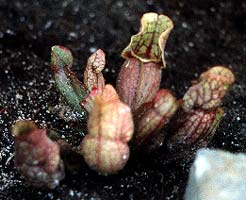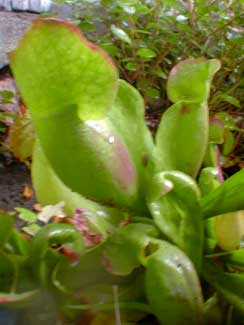
Veined Purple Pitcher Plant
"The season brimmed all other things up
Full as the rain fills the pitcher-plant's cup."
-James Russell Lowell
(1819-1891)
(1819-1891)
The first photo snapped early July (2002) is of a young Veined Purple Pitcher Plant (Sarracenia purpurea ssp venosa var venosa). It has the smaller pitchers which are associated primarily with races of the veined subspecies that occur as far north as New Jersey, with S. purpurea ssp purpurea replacing it from New Jersey north through Manitoba & Labradore, the northern varieties having still smaller pitchers.
 This one was propagated by tissue culture, obtained from a Tacoma pond & tropicals specialty nursery. All pitcher plants should be obtained from cultivated sources, as vendors who steal them from the wild have placed extreme stresses on wild populations.
This one was propagated by tissue culture, obtained from a Tacoma pond & tropicals specialty nursery. All pitcher plants should be obtained from cultivated sources, as vendors who steal them from the wild have placed extreme stresses on wild populations.This low-growing species inspired additional common names with folksy charm: Huntsman's Cups, Sidesaddle Flytrap, Frog's Britches, Frog Bonnets, Fly Bugles, & two obsolute vulgarisms long ago applied to plants of this genus: Dumb-watches & Eve's Cups.
Eve's Cup derives from an old legend that Adam & Eve received cups of ambrosia from God, but Eve thought it smelled too strong, & deluted hers with berry juice, or possibly with squeezings of the Forbidden Fruit, which was sexual knowledge. Eve's Cup or Eve's Jar was simulatanously a polite way of alluding to her vagina. According to a myth of Arabic origin, with Zoroastrian borrowings, there was a time when Adam & Eve dwelt with other spouses, Adam with Lilith by whom he sired demonesses, & Eve with the Serpent to whom she bore demons, producing thereby a race older than humanity that was not exterminated until the time of the Flood. Thus it was said that when Adam & Eve dwelt apart, "Eve's cup held naught but worms & emitted a hellish stench." So too a pitcher plant filled with rainwater is polluted with rotting insects.
The parallel vulgarism Dumb-watch alludes to the pitcher plant as Adam's groin, Dumb-watch being an old term for syphilitic, plague, or gonorrhaeic pustules. Venerial diseases were formerly believed to be treatable with exudates of such carniverous flora as pitcher plants, sundews, & venus flytraps.
Although it's not entirely out of the question that some small benefit was to be had from such treatments, the belief was mainly based on the mystic Doctrine of Signatures rather than on observable effect. Within this doctrine, God was said to have placed a clue with every plant as to its medicinal value. Those pitcher plants which produced rounded swollen leaves filled with fouled water were thought to resemble "bubos" or diseased & inflamed lymph-nodes, therefore this plant would treat just such maladies. Today we much prefer to see a more wholesome resemblance to pitchers & trumpets rather than to bubos.
In the wild this pitcher plant loves boggy lake margins. It is lower growing than other popularly cultivated pitcher plant, its pitchers being nearly prostrate or at least leaning at a sharp low angle. Not all its leaves become pitchers but are large flat undulating leaves for photosynthesis, & these are produced in greater numbers at the start of autumn. Such non-pitcher leaves are called phyllodia, & they often last through the whole of winter though the insect-catching cups die back.
The pitchers of low-growing pitcher plants which lay backward on the ground literally fill up with rainwater, capturing & drowning crawling insects such as woodlouse & small beetles. They require rainfall or its substitution with gentle overhead watering or misting so that the pitchers gather water to maximize their ability to capture insects. By comparison, tall pitcher plants like Sarracenia leucophylla are more apt to be capturing moths & other flying insects & rather than filling up with water, they have fine hairs down the throat of the specialized leaves so that anything that enters goes "with" the slippery hairs straight down into the trumpet, but when they turn around the stiff hairs stop them from climbing back out.
Despite that they eat insects, evolution is never sitting still, & there are moth larvae that have adapted to feeding on Purple Pitcher Plants, flies that have learned to enter the pitchers safely to feed on dead insects, & even a small non-biting mosquito that lays its eggs & hatches its aquatic larvae exclusively in the Purple Pitchers!
The veined subspecies is more robust than the northern non-veined S. purpurea ssp purpurea, & is one of the easiest pitcher-plants to grow, being suited to a very wide range of temperatures.
They like acidic wet soil & as much sunlight as possible, at least six hours. However, the second photo from late October (2005) shows the same plant in a bright shade location where it had been growing doing fine for about two years with less than optimal sun. It lost a great deal of its purple veining but otherwise did not mind this location. I keep intending to move it to a bog-container in full sun but have long neglected that done.
They must never dry out, neither in summer nor winter. Although difficult to keep alive indoors where humidity is generally too low to sustain them, they are easily grown outdoors in our mild Puget Sound microclimate. Indeed, this particular specimen, even though quite neglected all year, when I finally cleared weeds away from it, it looked healthy & happy & had grown & spread to three or four times its size when it was planted.
Sarracenia purpurea ssp venosa var montana 'Carolina 3'